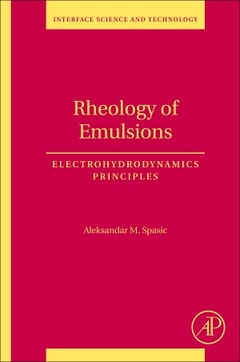Rheology of Emulsions Electrohydrodynamics Principles Interface Science and Technology Series
Auteur : Spasic Aleksandar M. M.

Rheology of Emulsions, Volume 22: Electrohydrodynamics Principles studies phenomena at liquid-liquid interfaces, including finely dispersed particles or structures, in particular emulsions, double emulsions and biological cells. The book considers the forces of electrical origin that participate in the physical events at liquid-liquid interfaces, taking into account electron transfer phenomenon and electrodynamics principles. Topics covered are of interest to a broad range of scientists, researchers and graduate students with a basic knowledge of physical chemistry, electromagnetism, fluid mechanics, classical and quantum electrodynamics.
The implications and applications of the material presented in the book contribute to the advanced fundamental, applied and engineering research of interfacial electroviscoelastic phenomena.
1. Introduction 2. Historical Review and Motivation 3. Classification and Methodology – Finely Dispersed Systems 4. Rheology - Constitutive Models of Liquids 5. Theory of Electroviscoelasticity 6. Experimental Corroboration 7. Possible Further Development or Perspectives 8. Implications and Conclusive Remarks
Scientists, researchers and graduate students in
chemical engineering, colloid and interface science, nanoscience & nanotechnology, biology and biomedicine
- Features a multidisciplinary approach to electron transfer phenomena
- Introduces a new constitutive model of liquids and a theory of electroviscoelasticity
- Addresses a broad range of subject field examples that make it useful to various research communities
Date de parution : 04-2018
Ouvrage de 188 p.
15x22.8 cm
Thèmes de Rheology of Emulsions :
Mots-clés :
Coalescence; Constitutive models; Double emulsion; Droplet formation process; Electrical interfacial potential; Electro viscosity; Electrocoalescence; Electrodynamics; Electrohydrodynamics; Electromechanical analogies; Electroviscoelasticity; Energetic analysis; Finely dispersed systems; Fractional order calculus; Hydrodynamics; Liquid-liquid contact cell; Marangoni instabilities; Memory storage; Memristive systems; Memristor; Nuclear magnetic resonance; Rheology; Spherical interfaces; Spontaneous oscillations; Structure



